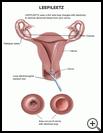
LEEP/LLETZ
________________________________________________________________________
KEY POINTS
- LEEP/LLETZ is a procedure to remove abnormal tissue from your cervix. It uses a thin wire loop charged with electricity to remove the tissue.
- The procedure may be done to remove cells for diagnosis or treatment, or to treat inflammation of the cervix.
- Ask your provider how long it will take to recover and how to take care of yourself at home.
- Make sure you know what symptoms or problems you should watch for and what to do if you have them.
________________________________________________________________________
What is LEEP/LLETZ?
LEEP is a procedure to remove abnormal tissue from your cervix. It uses a thin wire loop charged with electricity to remove the tissue.
The cervix is the lower part of the uterus that opens into the vagina. The uterus is the muscular organ at the top of the vagina. Babies grow in the uterus, and menstrual blood comes from the uterus, through the cervix.
LEEP stands for loop electrosurgical excision procedure. It is also called large loop excision of the transformation zone, or LLETZ.
When is it used?
This procedure is done to:
- Remove cells from your cervix to help make a diagnosis
- Remove abnormal cells from your cervix, including cells that might be cancer
- Treat inflammation of the cervix
- Check the results of other tests
Ask your healthcare provider about your choices for treatment and the risks.
How do I prepare for this procedure?
- Tell your healthcare provider if you think you may be pregnant. Your provider may wait to do this procedure until after your baby is born.
- Plan to have the exam when you are not having a menstrual period. These procedures are usually not done during your period.
- Your healthcare provider may recommend that you do not douche, use vaginal creams or ointments, or have sex for a few days before the exam.
- You may or may not need to take your regular medicines the day of the procedure. Tell your healthcare provider about all medicines and supplements that you take. Some products may increase your risk of side effects. Ask your healthcare provider if you need to avoid taking any medicine or supplements before the procedure.
- Tell your healthcare provider if you have any food, medicine, or other allergies such as latex.
- Follow any other instructions your healthcare provider gives you.
- Ask any questions you have before the procedure. You should understand what your healthcare provider is going to do. You have the right to make decisions about your healthcare and to give permission for any tests or procedures.
What happens during the procedure?
The procedure may be done in your healthcare provider’s office or an outpatient clinic.
You will lie on your back on the exam table with your knees bent and the heels of your feet in stirrup heel holders. You will be asked to slide your hips to the end of the table and let your knees tilt to each side so that your legs are spread apart.
Then your healthcare provider will gently put a thin, lubricated tool called a speculum into your vagina. The speculum holds open the walls of the vagina so your provider can see the cervix. Your healthcare provider will put a chemical on your cervix that makes it easier to see abnormal tissue. Your healthcare provider may inject some numbing medicine into your cervix, then he or she will remove the abnormal tissue. The tissue will be sent to the lab for tests.
The procedure usually takes less than 5 minutes.
What happens after the procedure?
You can go home after the procedure.
You may have a little cramping after the procedure. You may also have some minor bleeding or spotting the first day or so after the procedure. For about 2 weeks you may have a brownish or blackish discharge. It may look like coffee grounds. This is a normal part of the healing of your cervix.
You should not put anything into your vagina such as creams, douches, or tampons, or have sex, for 2 weeks after the procedure.
Follow your healthcare provider's instructions. Ask your provider:
- How and when you will get your test results
- How long it will take to recover
- If there are activities you should avoid and when you can return to your normal activities
- How to take care of yourself at home
- What symptoms or problems you should watch for and what to do if you have them
Make sure you know when you should come back for a checkup. Keep all appointments for provider visits or tests.
What are the risks of this procedure?
Every procedure or treatment has risks. Some possible risks of this procedure include:
- You may have infection or bleeding.
- The cervical opening may get narrower or scarred, or the cervix may be weakened. These problems might make it harder for you to get pregnant.
Ask your healthcare provider how these risks apply to you. Be sure to discuss any other questions or concerns that you may have.

